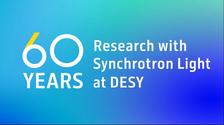60 years of research with synchrotron light at DESY - Logo (Credit: DESY)
The Deutsche Elektronen-Synchrotron DESY is celebrating ‘60 years of research with synchrotron radiation in Hamburg’ with a festive colloquium on 26 August 2024. Around 300 former companions are coming to DESY to mark the occasion. Since commissioning its first particle accelerator in 1964, DESY has been one of the world's pioneers of research with synchrotron light - a special type of X-ray radiation generated by these large-scale facilities. Since then, DESY's ‘light sources’ have been used to conduct high-calibre research which was even awarded a Nobel Prize in 2009. DESY's expertise also created a completely new type of large-scale research facilities: Free-electron lasers that can film chemical reactions in real time.
DESY was founded in Hamburg in 1959 and commissioned Germany's first particle accelerator in 1964, the largest accelerator in the world at the time. From the very beginning, the high-intensity X-ray radiation produced by such accelerators was characterized, and its potential for structural research was quickly recognised: The highly focussed synchrotron light can be used to produce images of atoms and molecules and thus decipher the function and secrets of materials. The successor accelerator DORIS was built in 1974 and the 2.3 kilometre-long PETRA storage ring followed in 1978. Both facilities became veritable treasure troves of science for thousands of researchers from Germany and all over the world, as did the world's first X-ray laser FLASH which has been available to a wide range of users since 2005.
For 60 years, the large-scale research facilities at DESY have stood for outstanding scientific excellence. Since 2009, the X-ray light source PETRA III has been a magnet for cutting-edge research, attracting more than 3,500 researchers from all over the world to carry out their experiments there every year. And this has a long tradition: HASYLAB, a large-scale laboratory for research with synchrotron radiation, was established in 1978. It quickly became one of the world's leading laboratory of its kind. For example, the Israeli scientist Ada Yonath decoded the structure of ribosomes at DESY's X-ray light source DORIS. Together with Venkatraman Ramakrishnan and Thomas A. Steitz, Ada Yonath was awarded the Nobel Prize in Chemistry in 2009.
In addition to scientific results, DESY's X-ray light sources generate economic benefits. For example, a study published in 2023 showed that PETRA III alone has had a considerable economic impact, generating more than 2 billion euros in added value over the last ten years.
From the early 1990s, DESY led a global co-operation to develop a completely new technology: superconducting linear accelerators that can produce laser light with X-ray wavelengths - X-ray laser light. Since 2005, DESY's 260 metre long free-electron laser FLASH has been the first facility of its kind in the world to generate flashes of light in the soft X-ray range which have been available to the international photon science community for their experiments.
In 2017, another particle accelerator built by DESY went into operation: The European XFEL, the largest X-ray laser in the world which generates up to 27,000 laser light flashes per second. The underground facility is more than three kilometres long and stretches from the DESY site in Hamburg to Schenefeld in Schleswig-Holstein where the research campus and experimental hall are located. Together with PETRA III and FLASH, the European XFEL forms a globally unique system of research facilities for scientists working with synchrotron radiation - there is a suitable experimental environment here for every scientific question.
DESY is now taking the crucial step towards revolutionising research with X-ray light: The planned PETRA IV accelerator facility will be a 3D X-ray microscope that will surpass everything that has been done before in terms of brilliance and performance. Maximum focussing of the X-ray light - i.e. the ultimate bundled X-ray beams - will produce three-dimensional structural images; around a hundred times more detailed than at PETRA III. The world's most powerful storage ring X-ray light source will then generate data which - together with a novel operating concept - will closely interlink basic and applied research and thus significantly accelerate the gain in knowledge and further consolidate Germany's technological sovereignty.
(from DESY News)








